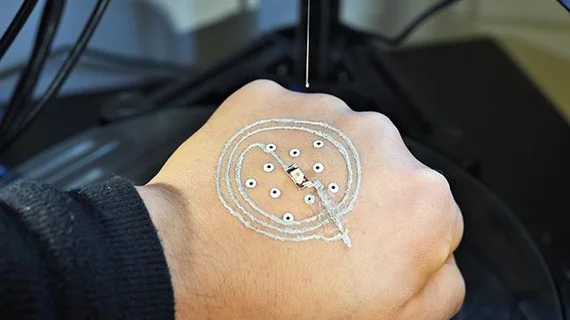3D printer prints electronics directly onto skin
Researchers from the University of Minnesota have developed a 3D printer capable of printing electronics directly onto the skin, according to a study published April 25 in Advanced Materials.
The device specialized ink to print temporary sensors to the skin. Researchers hope this procedure could provide insights into developing new treatments for healing wounds while also being able to print grafts.
"We are excited about the potential of this new 3D-printing technology using a portable, lightweight printer costing less than $400," said Michael McAlpine, the study's lead author and the University of Minnesota Benjamin Mayhugh Associate Professor of Mechanical Engineering. "We imagine that a soldier could pull this printer out of a backpack and print a chemical sensor or other electronics they need, directly on the skin. It would be like a 'Swiss Army knife' of the future with everything they need all in one portable 3D printing tool."
Researchers placed temporary markers on the skin and scanned the area. A computer is then able to view the surface and adjust movement in real-time. The specialized ink, made of silver flakes, allows for the sensors to be placed onto the skin at room temperature. To remove the sensor, individuals can peel off the device with tweezers or wash it off with water.
"No matter how hard anyone would try to stay still when using the printer on the skin, a person moves slightly and every hand is different," McAlpine said. "This printer can track the hand using the markers and adjust in real-time to the movements and contours of the hand, so printing of the electronics keeps its circuit shape. I'm fascinated by the idea of printing electronics or cells directly on the skin. It is such a simple idea and has unlimited potential for important applications in the future."

